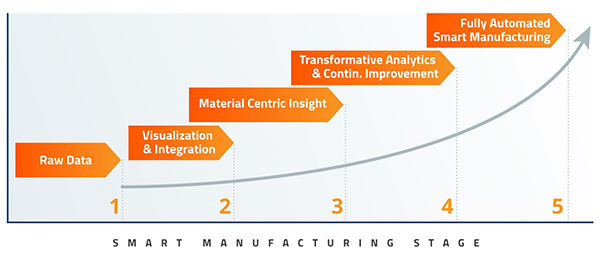By adopting advanced technologies and investing in workforce training, food and beverage factories are preparing for the future.
By Doug Lawson, CEO, ThinkIQ
Manufacturing is no longer simply about making physical products. Changes in consumer demand, the nature of products, the economics of production, and the economics of the supply chain have led to a fundamental shift in the way companies do business. Added sensors and connectivity turn “dumb” products into “smart” ones, while products increasingly become platforms—and even move into the realm of services.
Manufacturing executives know that the factory of the future offers an extraordinary tomorrow that has already begun to make the world go round with incredible speed and efficiency. That’s why many manufacturing experts believe the time is right to invest in smart manufacturing and the internet of things (IoT). According to the recent State of Manufacturing Report, 91% of respondents indicated they have increased digital transformation investments in the past year, while 84% have embraced on-demand manufacturing technologies.
Disruptive technologies promise to close the gap between previous manufacturing limitations and unprecedented customer demand. New and developing technologies such as mobility allow vital communications to be made from anywhere globally. Late-stage assembly processes such as integrated CAD systems allow for greater customization on a mass scale. Robotics have led to shop-floor automations that are a game-changer for workflows and production cycles. Big data and artificial intelligence (AI) have made factory processes and customer expectations more predictable. The cloud itself makes vast data repositories more digestible.
One of the big breakthroughs the factory of the future offers is greater collaboration between human and machine. Robots can now work alongside humans on the factory floor via intelligent sensors, advanced safety parameters, and greater dexterity to pick, place, sort, and load faster. These strides in robotics achieved in harmony with human counterparts have led to swifter technical adjustments in format and speed. By injecting adaptive control and self-learning capabilities into the factory, product types can be switched in an instant and technical adjustments are possible without having to halt production.
The smart utilization of sensors can lead to real-time adjustments. Connected by data communications systems, information can now be routed faster between man and machine. That data is collected in the cloud to track trends and identify improvements in the manufacturing process.
These AI-enabled applications also result in enhanced safety. Autonomous robots can minimize any challenge that crops up to maximize the well-being of the people they work alongside. Machines even talk to each other using cloud connectivity to automate mission-critical processes. Disparate systems have become connected and can pump out actionable insights to their operators. As such, both energy and water waste can be minimized for more environmentally sustainable operations. When systems are connected, optimizations can be made to production line systems in days or hours. Restocks can be automated when inventory runs low and downtime avoided through predictive maintenance.

In the food and beverage industry, the factory of the future does not shrink at the challenge of food safety, quality assurance, government regulation, or consumer demand for clean-label products. Raw material traceability is vital in eliminating risk recall, improving yield, and reducing waste. And such gains aren’t good just for reputation and sustainability, they’re good for the bottom line.
Of course, the use of digital technologies at each stage of the food supply chain is still evolving; very few participants that chain are fully digital and automated, although the movement in that direction seems inexorable. But technology alone won’t bring about all the benefits attributed to digitization. For that to occur, there have to be opportunities for workforce training and education to make effective use of those technologies. There need to be partnerships that span different sectors of the food industry to identify best practices and benchmark effective processes.
The demands on the manufacturing industry will continue due to the trend for more on-demand production and the ever-present drive to reduce costs. Smart factories optimize efficiency and productivity by extending the capabilities of both manufacturing devices and people. By investing in the factory of the future by adopting advanced technologies and proper workforce training, manufacturing companies will find themselves ahead of many of their competitors.

Doug Lawson is the CEO of ThinkIQ, a pioneer of Digital Manufacturing Transformation SaaS.
Doug has founded, built and sold multiple software startups in the Industrial Sector. His understanding of customer challenges and his leadership creating innovative products to meet those challenges is widely respected in the Industry.
In this episode, I sat down with Beejan Giga, Director | Partner and Caleb Emerson, Senior Results Manager at Carpedia International. We discussed the insights behind their recent Industry Today article, “Thinking Three Moves Ahead” and together we explored how manufacturers can plan more strategically, align with their suppliers, and build the operational discipline needed to support intentional, sustainable growth. It was a conversation packed with practical perspectives on navigating a fast-changing industry landscape.